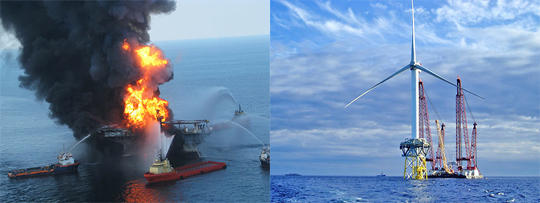Shift your mindset from hell to heaven

How does the BP oil disaster affect our businesses? Its effects on businesses in the Gulf are obvious. As a savvy business owner, do you see its effects on your own? Sometimes the answer is so close, we just can’t see it.
As one way to light a candle, rather than curse the darkness, I offer this mindset shift.
In Ian McEwan’s book, “Solar,” a physicist tells the story of a man living in a rainy forest. The man is terribly thirsty. He has been cutting down trees to get at the sap, so he can quench his thirst. The destruction all around him is evidence of his desperate quest to find something to drink. Sure, he could just tilt up his head, open his mouth and let the rain in. Or he could make a bowl to catch the rain. But he’s just so good at cutting down trees. So that’s what he continues to do.
It’s an allegory of our quest for energy: we go to greater and greater lengths to dig up ancient trees and sunlight in the form of fossil fuels. And yet, the earth receives more energy from the sun in just one hour than the world uses in a whole year. But we are just so good at pulling up fossil fuels. So that’s what we continue to do.
One great distinction I’ve heard recently (in Tom Friedman’s book, “Hot, Flat, and Crowded“) is between fuels from hell (fossil fuels from the earth’s fiery crust) and fuels from heaven (solar, wind from the sky). We are living in such an interesting time; this shift from hell to heaven is taking place NOW.
To help you take advantage of this shift and contribute to your business success, here are:
Three tips to shift from hell to heaven
Tip #1: Measure Thyself. There’s that old adage, you can’t manage what you don’t measure. Awareness is the first step towards positive change. Your local utility very likely has a program to support businesses in reducing energy use. An audit is the best first step, as it gives you a baseline to measure progress.
Tip #2: Get Smart. Reduce your energy use as much as possible. Two suggestions: 1) Go around your office and plug everything into smart strips. Turn off strips with equipment that’s not in use. This goes for cell-phone chargers and anything with a bulky box at the plug end. These items use energy even when the device is turned off. 2) Lighting retrofits can save buckets of money. Contact a company like Alliance Energy Solutions for turn-key service. They package tax credits and other incentives, even zero-interest loans if you qualify, to make it very affordable. Then, you get to sit back and enjoy the savings from your new, highly efficient lighting.
Tip #3: Welcome the Sun. Two suggestions: 1) Buy Renewable Energy Credits (REC’s), either via your utility or through a third party like Clean Currents or WindCurrent. RECs go to fund wind turbines and solar installations that sell clean energy to the grid. 2) If you own your building, look into putting solar panels on the roof. Most solar installers offer pricing packages that roll in the various incentives from local, state, and federal programs. In some states, this makes the price of solar very attractive.
Were these tips helpful? Let us know. We’d love to hear what else you’re doing to welcome the sun.





 View the dynamic, moving GOforChange: Greening Baltimore video
View the dynamic, moving GOforChange: Greening Baltimore video

Comment by Christine Buffaloe on 23 June 2010:
It’s funny that you should mention about the smart strips. In my office I have many of them, but they are all connected in some way to my computer and such. I am going to start turning them off at the end of the day.
I do go around the house and unplug items that are not in use, such as the toaster, wash machine and dryer.
I never thought of unplugging my business equipment.